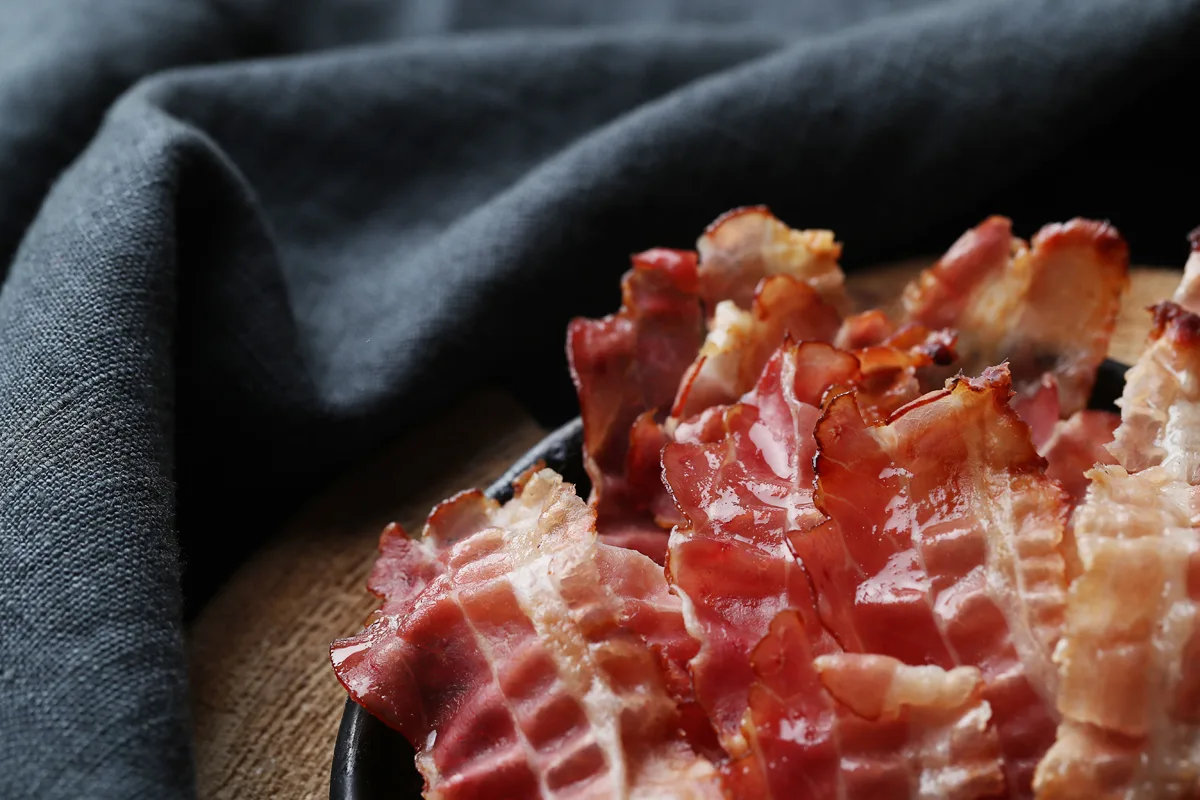Bacon is a crispy, salty delight that’s perfect any time of day.
But have you ever thought about where bacon comes from? What part of the pig is bacon?
Contents
How Is Bacon Made?
In short, bacon is a fresh slab of pork that’s dry-cured. It is called a dry cure because it does not contain liquids like water.
The bacon is coated with salt and seasonings such as sugar.
The bacon is cured in a controlled environment so the curing ingredients can penetrate the meat.
Usually, after the bacon has been cured, the salt cure is rinsed off.
The bacon is then placed into a smoker to infuse it with a smoky flavor and preserve it even more.
If the bacon is not smoked, it is allowed to air dry in a cold environment for several weeks or months.
Can You Get Bacon From a Cow?
Bacon is most associated with pork. However, since cows do have bellies means a butcher can make bacon.
Beef bacon is much harder to find. So, you may have to visit your local butcher or buy it online.
Is Bacon the Same as Pork Belly?
In one sense, bacon is pork belly. However, in another sense, pork belly is not bacon.
It’s the same thing as pork chops being pork but all pork not being pork chops.
Pork belly is the whole slab of meat, while bacon is carved from the slab of pork belly.
In addition to this, pork belly is not cured or smoked, while bacon is cured and smoked.
What Part of the Pig Is Bacon?
Contrary to popular belief, bacon does not come from one central location.
Most people assume bacon is fabricated from pork belly, but this is just one type of bacon.
It can come from the pig’s belly, ribs, sides, loin, or any part of the pig with rich fat content.
Therefore, bacon is fabricated from different parts of the pig.
Types of Bacon
To further break down what part of the pig bacon comes from, let’s examine where each type of bacon comes from.
Center-cut Bacon
Center-cut bacon is the most popular type of bacon. Center-cut bacon is considered traditional since it is fabricated from the sides of the hog.
However, center-cut bacon has the fat-rich ends removed to decrease the total amount of grease that’s generated when you prepare it.
Because of its decreased fat content, center-cut bacon costs more than traditional bacon.
Center-cut bacon is usually pan-fried in a skillet, used as a topping for a BBQ hamburger, or wrapped around BBQ meatloaf.
Canadian Bacon
Canadian bacon is fabricated from the loin primal, which is near rear portion of the hog.
It is cut from the same region where pork chops are fabricated from.
Canadian bacon does not contain high levels of fat like regular bacon does, and it resembles ham.
Canadian bacon is used for the ever-popular dish known as eggs benedict.
However, Canadian bacon can also be a stand-alone dish or served as a side dish or as sandwich meat.
Jowl Bacon
Jowl bacon is fabricated from the cheek of the animal. Jowl bacon is also called guanciale.
While it has a similar makeup to conventional bacon, jowl bacon contains more fat.
In addition to this, it is not as neat and uniform as traditional bacon. Thicker cuts of jowl bacon are called bacon steaks.
You can smoke jowl bacon in your offset smoker or fry it on the stove.
You can eat jowl bacon as a stand-alone dish or use it in foods that call for pork belly.
Buckboard Bacon
Buckboard bacon or cottage bacon is fabricated from pork butt.
While its flavor is much richer than traditional bacon, it is also much tougher since it originates in the hog’s shoulder.
Buckboard bacon needs to be sliced thinly and cooked quickly. However, if it is cut into thicker slices, it can be used like a steak.
Pancetta
Pancetta is a variety of bacon that’s primarily associated with Italy. However, pancetta is used throughout the Mediterranean region.
Pancetta is fabricated from pork belly and is stored in a container of brine once it’s been cured.
Pancetta can be cut into thin slices or diced into cubes. Pancetta can be consumed raw on an antipasti plater, as a pizza topping, or as carbonara.
Final Thoughts
Now that you know where bacon comes from on the pig, you can confidently cook up bacon for your morning breakfast spread or cheeseburgers or chop it up and add it to other dishes.
You might also be interested in the following:
- What Part of the Pig Is Chorizo
- What Part of the Pig Is the Ham Hock
- What Part of the Pig Is Pork Chops
- What Part of the Pig Is Ham

I have been smoking and grilling meat from an early age and enjoy sharing my knowledge and expertise through the hundreds of articles I have written about BBQ. I hope to make everyone’s BBQ journey that little bit easier.

